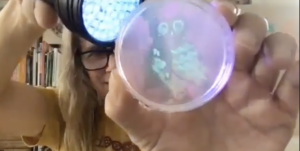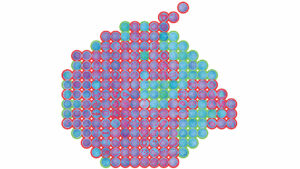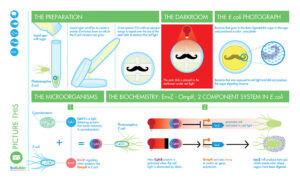
Peanut butter and jelly…spaghetti and meatballs…painting and bacteria. Wait, what?
It may sound like the most impossible combination, but it’s just the kind of art + science mashup that Karen Ingram (’96 BFA Studio Art, Concentration in Painting) loves to explore:
“I think there’s a real overlap, and I think that the more conscious we are as artists about that overlap, the more we can work with things like bacteria as a material. Art and Science are closer than you think. I’m interested in the idea of using bacteria as a medium but also conceptually what that means for the future of technology and biotechnology.”
Ingram is an artist, graphic designer, and creative director who focuses on science communications. She does work for government entities, and higher education. She got interested in bio-art after co-organizing a speaker series called the Empiricist League which is described by the science, politics, and tech outlet FiveThirtyEight as an
“ad-hoc, small scale TED Talk for scientists and the New Yorkers who adore them.”

“I helped out with this bio-art exhibit that was put on by a community biotech lab called GenSpace at South by Southwest. It involved around 200 people. Each participant was given a kit to make a tile. Each participant drew a design on a card then placed the card under the petri dish, dipped a toothpick into the bacteria, and traced the design. We gathered all of the tiles, photographed them, and put them into the shape of a unicorn. It’s a really interesting process as an artist because you can’t see the bacteria. You have to wait for it to grow, and it takes 24-48 hours while you’re painting with it for it to incubate and actually turn into something.”
Ingram likes the unpredictability of bio-art:
“Seeing how the different Petri dishes rendered the bacteria was fascinating. Some bacteria grown under natural light were very diverse in their chroma. And that was kind of a surprise since it all came from the same place. There are all these hidden variables when you’re working with bio-art. It’s a true collaboration between you and nature.”
Ingram’s exploration of bio-art isn’t limited to painting:
“I went to MIT to a class taught by Natalie Kuldell to get an example of bacterial photography, which is different than bacterial painting in that you’re actually engineering a microbe to react to light. I was working with genes from cyanobacteria which naturally respond to light and putting those genes into Ecoli. Once you engineer the Ecoli to have the cyanobacteria genes, you put the Ecoli in a special darkroom and place a film over it. Wherever it’s dark, where the light doesn’t hit it, is what produces the image. We put our plates in the bacterial darkroom and they just didn’t work. Sometimes it just doesn’t work. Sometimes the bacteria is unable to pick up what you want it to and doesn’t produce the image. That’s working with nature.”
When her bacterial photography didn’t work, Ingram decided to do some reading on the subject, but all of the material was in very specific scientific jargon that she says she just couldn’t comprehend, so she translated into a language that she’s proficient in—the language of Art:
“I tried and tried to read this one article but I couldn’t understand any of it because I don’t have a PhD in Biochemistry, so what I did instead was I just started color coding the paper by function and interactions of things, and using the notes and photos I had taken in Natalie’s class, I wound up boiling the paper down into a one-page schematic.”

The professor saw Ingram’s diagram and asked if she could use it in her forthcoming book:
“I was really flattered and excited by that, but I also found it kind of funny. I was just just trying to make the information more accessible to my brain. I thought I was making a tool for artists to understand the process of bacterial photography, but it ended up being a tool for engineers.”
Even though Ingram couldn’t get the bacterial photography experiment to work, her graphic interpretation of the process led to a collaboration that resulted in the book Biobuilder: Synthetic Biology in the Lab by Natalie Kuldell, Rachel Bernstein, Katie Hart, and Karen Ingram. Following the release of the book, the team of authors have expanded the BioBuilder curriculum from academia into DIY biotech labs, makerspaces, and art spaces and institutions.
Ingram sees connections between what she is doing now and her time as a student at UNC Greensboro:
“My work with bacteria aligns a lot with the printmaking classes that I took especially with etching because it’s a process of working through different layers and using acid to eat through a material to make an image. I don’t think that’s a process I would necessarily have had access to if not for those printmaking classes. I also think my art classes at UNCG taught me to be comfortable with working with different materials and how to use them safely and responsibly. That’s a big element of bio-art, too.”
After graduation, Ingram worked at Cone Mills working with computer-assisted design systems. When she moved to New York, it was to do charts and graphs for a company that published data analytics from research reports:
“My path has been interesting—from an art education to textiles to technology and now it’s some kind of hybrid of all of that. I think for a lot of people the journey doesn’t make any sense, but for me it makes perfect sense.”
Ingram hopes that bio-art will one day play a big part in bringing sustainability into the picture:
“I think in the future instead of mining for pigments we might be able to grow them. Inks made from bacteria could be a more sustainable option. I can make this type of ink in my own kitchen now. It’s complicated and time-consuming, but who knows how soon we’ll be able to produce them on a larger scale.”
Story by Terri W. Relos